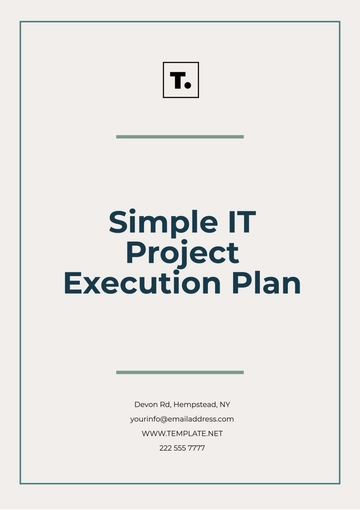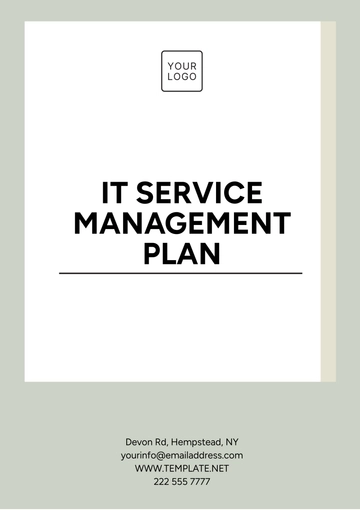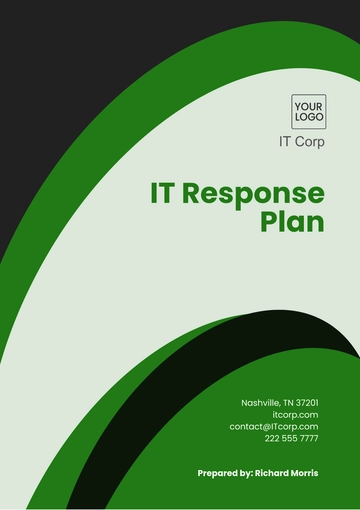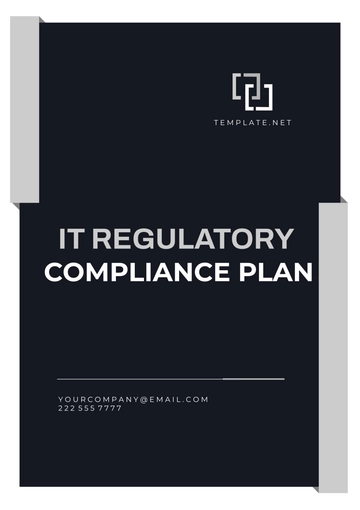Free IT Vendor Management Plan
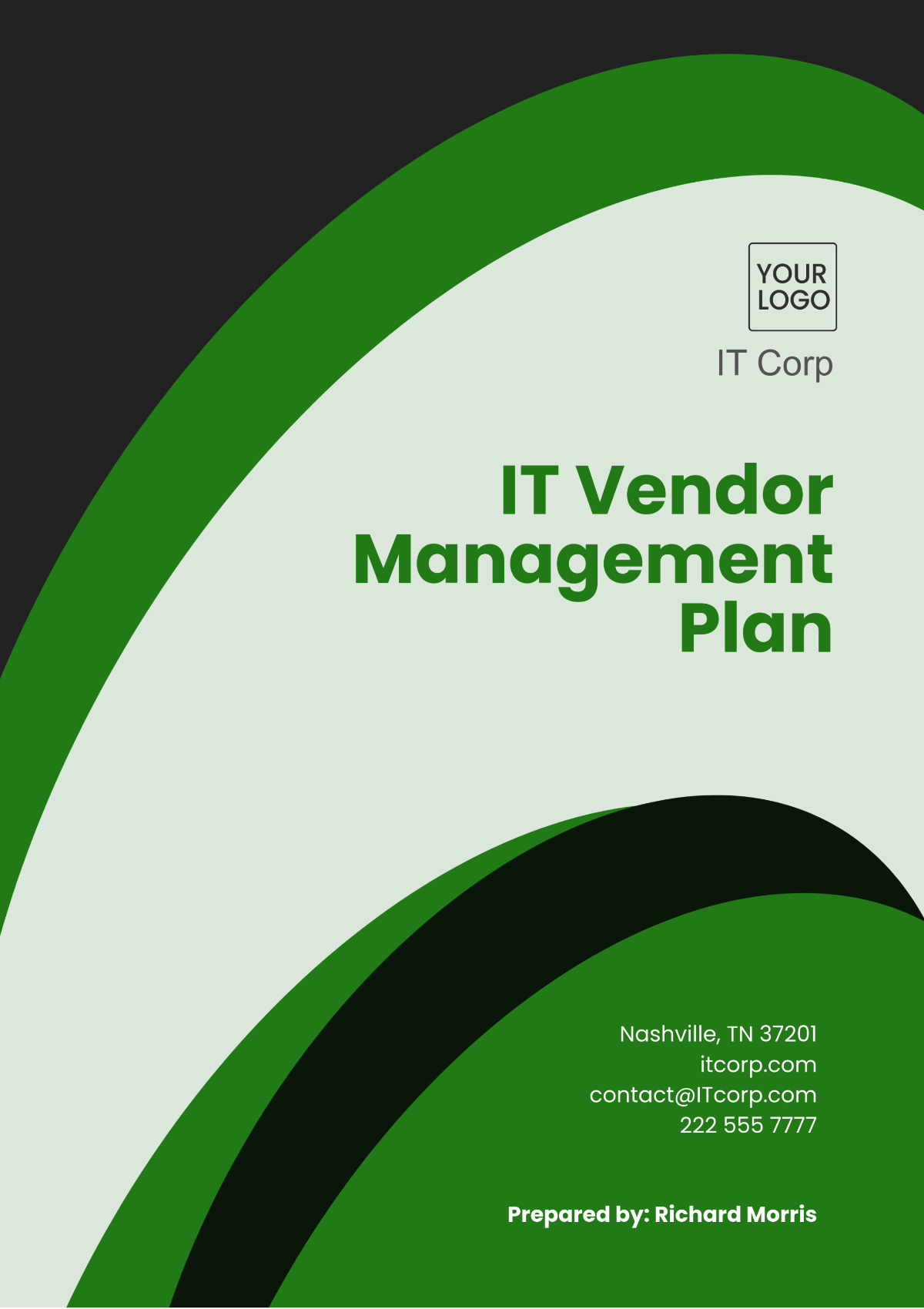
1. Introduction
1.1 Purpose
The purpose of this IT Vendor Management Plan is to establish a structured approach for managing [Your Company Name]’s relationships with IT vendors. This plan aims to ensure that all vendor engagements align with the company's strategic objectives and operational requirements. By defining clear processes for vendor selection, contract management, performance monitoring, and risk mitigation, the plan seeks to enhance vendor contributions, optimize performance, and mitigate potential risks associated with vendor relationships. The plan serves as a guide for both internal stakeholders and vendors, promoting transparency, accountability, and effective collaboration.
1.2 Scope
This plan encompasses all IT-related vendor interactions within [Your Company Name], including but not limited to:
Software Vendors: Providers of enterprise software, applications, and development tools.
Hardware Vendors: Suppliers of servers, workstations, networking equipment, and peripherals.
Consulting Services: Firms offering IT consulting, implementation, and advisory services.
Support Services: Providers of technical support, maintenance, and managed services.
The scope includes all phases of the vendor lifecycle, from initial selection and contract negotiation through performance management and risk assessment. It applies to both strategic and tactical vendor relationships, ensuring comprehensive oversight and integration with the company's IT and business strategies.
1.3 Objectives
The objectives of this plan are:
Define Procedures: Establish clear procedures for vendor selection, evaluation, and management to ensure consistent and effective practices.
Enhance Performance: Improve vendor performance through clearly defined metrics, regular reviews, and constructive feedback.
Mitigate Risks: Identify, assess, and manage risks associated with vendor relationships to prevent disruptions and ensure compliance.
Optimize Costs: Achieve cost efficiencies through effective negotiation, performance management, and alignment of vendor services with organizational needs.
2. Vendor Selection and Evaluation
2.1 Vendor Selection Criteria
To select the most suitable IT vendors, [Your Company Name] will evaluate potential vendors based on a comprehensive set of criteria:
Technical Capabilities: Evaluate the vendor’s technological proficiency and ability to meet specific requirements. This includes reviewing the vendor's technology stack, innovation capabilities, and future-proofing strategies. Ensure that the vendor's solutions align with [Your Company Name]’s current and future technological needs.
Experience and Reputation: Assess the vendor’s track record, industry experience, and reputation. Consider factors such as past project success, client testimonials, and industry awards. A vendor with a strong reputation and extensive experience is more likely to deliver high-quality services and products.
Financial Stability: Review the vendor’s financial health to ensure their stability and long-term viability. Analyze financial statements, credit ratings, and any history of bankruptcy or financial difficulties. A financially stable vendor is less likely to face disruptions that could impact service delivery.
Compliance and Security: Verify the vendor’s adherence to industry standards and regulatory requirements, including data protection and cybersecurity. Ensure that the vendor has robust security measures in place and complies with relevant laws and regulations to protect sensitive information.
2.2 Evaluation Process
The process for evaluating and selecting IT vendors involves several key steps:
Request for Proposal (RFP): Develop and issue a detailed RFP to potential vendors. The RFP should include a comprehensive description of the requirements, scope of work, evaluation criteria, and submission deadlines. The RFP serves as the primary tool for soliciting vendor proposals and comparing them based on predefined criteria.
Proposal Review: Assemble a review committee to evaluate vendor proposals. The committee should consist of representatives from relevant departments, including IT, procurement, and finance. Use a standardized scoring system to assess each proposal based on the selection criteria, ensuring an objective and fair evaluation process.
Vendor Interviews: Conduct interviews or presentations with shortlisted vendors to gain deeper insights into their capabilities and solutions. Use these interactions to clarify any questions, assess the vendor's understanding of [Your Company Name]’s needs, and evaluate their ability to communicate and collaborate effectively.
Reference Checks: Perform thorough reference checks by contacting previous or current clients of the vendor. Seek feedback on the vendor’s performance, reliability, and ability to meet contractual obligations. Reference checks provide valuable insights into the vendor’s track record and client satisfaction.
Final Selection: Based on the evaluation results, vendor interviews, and reference checks, make the final selection of the most suitable vendor(s). Document the rationale for the selection decision, including how the vendor meets [Your Company Name]’s needs and aligns with organizational goals. Prepare a recommendation report to support the decision and facilitate contract negotiations.
3. Contract Management
3.1 Contract Negotiation
Effective contract negotiation is essential for establishing clear, fair, and comprehensive agreements with IT vendors. Key elements of the negotiation process include:
Scope of Work: Clearly define the scope of work in the contract, including detailed descriptions of the services or products to be provided. Specify deliverables, project milestones, and any expected outcomes. Ensure that the scope of work aligns with [Your Company Name]’s requirements and objectives.
Pricing and Payment Terms: Agree on pricing structures, payment terms, and conditions. This includes negotiating the overall cost, payment schedules, and any potential discounts or penalties for non-performance. Ensure that payment terms are aligned with project milestones or deliverables and that pricing is competitive and transparent.
Service Level Agreements (SLAs): Develop comprehensive SLAs that outline the expected level of service, including response times, resolution times, and performance standards. Define metrics for measuring vendor performance and procedures for handling service failures. SLAs should include provisions for monitoring performance and addressing any deviations from agreed standards.
Legal and Compliance Requirements: Include provisions in the contract to ensure compliance with relevant laws, regulations, and industry standards. This includes data protection laws, intellectual property rights, and confidentiality requirements. Ensure that the contract addresses legal and regulatory obligations to protect [Your Company Name]’s interests.
3.2 Contract Administration
Effective contract administration ensures that the terms of the contract are adhered to and managed throughout its lifecycle. Key activities include:
Contract Execution: Ensure that all parties sign the contract and that it is properly executed. Maintain copies of the signed contract for reference and compliance. Ensure that the contract is stored securely and accessible to authorized personnel.
Contract Changes: Implement a formal process for managing contract changes or amendments. Document any changes to the scope of work, pricing, or terms, and ensure that all parties agree to the amendments. Update the contract documentation to reflect any changes and communicate updates to relevant stakeholders.
Performance Monitoring: Regularly review and monitor vendor performance against the contract terms and SLAs. Use performance metrics, reporting tools, and feedback mechanisms to track progress and identify any issues or deviations. Address performance issues promptly and ensure that corrective actions are taken as needed.
Issue Resolution: Address any issues or disputes that arise during the contract term. Follow the dispute resolution procedures outlined in the contract to resolve conflicts and ensure that all parties fulfill their obligations. Maintain records of all issues and resolutions for future reference and accountability.
4. Vendor Performance Management
4.1 Performance Metrics
Establishing and monitoring performance metrics is crucial for evaluating vendor performance and ensuring alignment with [Your Company Name]’s objectives. Key performance metrics include:
Service Quality: Measure the quality of the services or products provided by the vendor. This can be assessed through customer satisfaction surveys, performance reviews, and feedback from internal stakeholders. High service quality is essential for achieving operational goals and maintaining client satisfaction.
Timeliness: Assess the vendor’s ability to meet deadlines and deliver on time. Monitor project timelines, delivery schedules, and response times to ensure that the vendor adheres to agreed timelines. Timely delivery is critical for maintaining project momentum and meeting business needs.
Cost Efficiency: Evaluate the cost-effectiveness of the vendor’s services. Compare actual costs against budgeted amounts and assess any cost savings or overruns. Ensure that the vendor provides value for money and adheres to agreed pricing structures.
Compliance: Ensure that the vendor complies with contractual obligations, industry standards, and regulatory requirements. Conduct regular audits and reviews to verify compliance and address any issues promptly. Compliance is essential for mitigating risks and maintaining operational integrity.
4.2 Performance Review Process
The performance review process involves several key steps to assess and manage vendor performance:
Regular Reviews: Schedule periodic performance reviews with the vendor to evaluate their performance against the established metrics. Use review meetings to discuss achievements, challenges, and areas for improvement. Provide constructive feedback and set expectations for future performance.
Feedback Mechanisms: Implement feedback mechanisms to gather input from internal stakeholders and end-users. Use surveys, interviews, and performance reports to collect feedback on the vendor’s performance. This feedback provides valuable insights into the vendor’s impact on organizational objectives and service delivery.
Action Plans: Develop action plans to address any performance issues or deficiencies identified during the review process. Work with the vendor to implement corrective actions and improvements. Monitor the progress of action plans and ensure that issues are resolved effectively.
Performance Reporting: Prepare performance reports that summarize the vendor’s performance against the metrics and SLAs. Share these reports with key stakeholders and use them for decision-making and future planning. Performance reports should provide a clear and objective assessment of the vendor’s contributions and areas for improvement.
5. Risk Management
5.1 Risk Identification
Identifying potential risks associated with vendor relationships is essential for proactive risk management. Key risk areas include:
Operational Risks: Risks related to the vendor’s operational capabilities, such as disruptions to service, technology failures, or resource constraints. Assess the vendor’s ability to maintain service continuity and manage operational challenges effectively.
Financial Risks: Risks related to the vendor’s financial stability, such as insolvency, bankruptcy, or changes in pricing structures. Evaluate the vendor’s financial health and ability to meet financial obligations to prevent potential disruptions.
Compliance Risks: Risks related to non-compliance with laws, regulations, or contractual obligations. This includes data breaches, security incidents, or violations of regulatory requirements. Ensure that the vendor adheres to compliance requirements and implements appropriate controls.
Reputational Risks: Risks that could impact [Your Company Name]’s reputation, such as poor service delivery, negative customer feedback, or unethical practices. Monitor the vendor’s performance and address any issues that could harm the company’s reputation.
5.2 Risk Mitigation Strategies
Implement strategies to mitigate identified risks and ensure effective management of vendor-related risks:
Risk Assessments: Conduct regular risk assessments to identify and evaluate potential risks associated with vendor relationships. Use risk assessment tools and techniques to prioritize risks and develop mitigation plans. Regularly update risk assessments to reflect changes in the vendor landscape.
Contingency Planning: Develop contingency plans to address potential risks and disruptions. Include backup vendors, alternative solutions, and recovery procedures in the contingency plans. Ensure that contingency plans are tested and updated regularly to ensure effectiveness.
Contractual Protections: Include risk mitigation provisions in vendor contracts, such as indemnification clauses, insurance requirements, and performance guarantees. Ensure that contracts address potential risks and provide mechanisms for managing and resolving issues.
Monitoring and Reporting: Implement continuous monitoring tools and techniques to track vendor performance and risks in real-time. Use monitoring data to proactively address any issues or deviations. Regularly report significant risks to key stakeholders and take appropriate actions to mitigate them.
6. Relationship Management
6.1 Building Strong Relationships
Building and maintaining strong relationships with IT vendors is crucial for effective vendor management and successful project outcomes. Key strategies include:
Communication: Maintain open and transparent communication with vendors. Schedule regular meetings, provide clear feedback, and address any concerns promptly. Effective communication fosters trust and collaboration between [Your Company Name] and its vendors.
Collaboration: Foster a collaborative relationship with vendors to achieve mutual goals. Work together on projects, share information, and support each other’s objectives. Collaboration enhances vendor engagement and helps resolve challenges effectively.
Recognition: Recognize and reward vendors for their achievements and contributions. Acknowledge their successes, provide positive feedback, and offer incentives for exceptional performance. Recognition motivates vendors to maintain high performance levels and strengthens the partnership.
6.2 Conflict Resolution
Implement strategies for resolving conflicts and managing disputes with vendors:
Dispute Resolution Procedures: Include dispute resolution procedures in vendor contracts. Outline the steps for resolving conflicts, including mediation, arbitration, or legal action. Clearly define the process for addressing and resolving disputes to ensure a fair and efficient resolution.
Negotiation: Engage in constructive negotiations to resolve disputes. Focus on finding mutually beneficial solutions and addressing underlying issues. Effective negotiation helps maintain positive relationships and ensures that conflicts are resolved amicably.
Escalation Procedures: Establish escalation procedures for handling unresolved conflicts. Identify key contacts and decision-makers for escalating issues and resolving disputes. Ensure that escalation procedures are well-defined and communicated to all parties involved.
7. Compliance and Auditing
7.1 Compliance Requirements
Ensure that vendors comply with relevant laws, regulations, and industry standards. Key compliance requirements include:
Data Protection: Ensure compliance with data protection laws and regulations, including GDPR, CCPA, and other data privacy requirements. Verify that vendors have appropriate data protection measures in place and handle personal data in accordance with legal requirements.
Security Standards: Verify that vendors adhere to security standards and best practices, including ISO 27001, NIST, and other cybersecurity frameworks. Ensure that vendors implement robust security measures to protect [Your Company Name]’s assets and information.
Contractual Obligations: Monitor compliance with contractual obligations, including service levels, performance metrics, and reporting requirements. Conduct regular reviews to ensure that vendors fulfill their contractual commitments and address any deviations.
7.2 Auditing and Monitoring
Implement auditing and monitoring processes to ensure ongoing compliance and performance:
Internal Audits: Conduct regular internal audits to review vendor performance, compliance, and contract adherence. Use audit findings to identify areas for improvement and ensure that corrective actions are taken. Internal audits help maintain oversight and accountability.
External Audits: Engage third-party auditors to assess vendor compliance and performance. Use external audits to gain an independent perspective and validate internal findings. External audits provide additional assurance and help identify potential areas of concern.
Continuous Monitoring: Implement continuous monitoring tools and techniques to track vendor performance and compliance in real-time. Use monitoring data to proactively address any issues or deviations from expected standards. Continuous monitoring enhances visibility and enables timely intervention.
8. Plan Review and Updates
8.1 Plan Review
Regularly review and update the IT Vendor Management Plan to ensure its effectiveness and relevance:
Annual Reviews: Conduct annual reviews of the plan to assess its effectiveness and identify any necessary updates. Review performance metrics, risk assessments, and compliance requirements to ensure that the plan remains aligned with organizational goals and industry standards.
Stakeholder Feedback: Gather feedback from key stakeholders and internal teams to identify areas for improvement. Use feedback to enhance the plan and address any emerging issues. Engage stakeholders in the review process to ensure that the plan reflects their needs and expectations.
8.2 Plan Updates
Update the plan as needed to reflect changes in organizational goals, industry standards, and regulatory requirements:
Policy Changes: Update the plan to reflect any changes in [Your Company Name]’s policies or procedures. Ensure that the plan aligns with current business practices and objectives. Communicate policy changes to relevant stakeholders and ensure that the plan remains up-to-date.
Regulatory Changes: Incorporate any changes in laws or regulations that impact vendor management. Ensure that the plan remains compliant with relevant legal and regulatory requirements. Stay informed about regulatory developments and update the plan accordingly.
Technological Advances: Update the plan to account for technological advancements and changes in the IT landscape. Ensure that the plan remains relevant in the context of evolving technology and industry trends. Adapt the plan to incorporate new technologies and best practices.
9. Conclusion
The IT Vendor Management Plan is a critical component of [Your Company Name]’s overall IT strategy. By implementing effective vendor management practices, [Your Company Name] can enhance vendor performance, mitigate risks, and achieve cost efficiencies. This comprehensive plan provides a structured approach to managing vendor relationships and ensuring alignment with organizational goals. Through careful planning, execution, and ongoing management, [Your Company Name] can maximize the value of its vendor partnerships and drive successful outcomes.
Appendices
Appendix A: Vendor Evaluation Checklist
Criteria | Description | Weight | Score |
|---|---|---|---|
Technical Capabilities | Expertise and alignment with requirements | [20%] | |
Experience and Reputation | Track record and industry standing | [15%] | |
Financial Stability | Financial health and stability | [15%] | |
Compliance and Security | Adherence to legal and security standards | [20%] | |
Pricing and Payment Terms | Cost structures and payment conditions | [10%] | |
Service Level Agreements (SLAs) | Defined service standards and performance metrics | [20%] | |
Total | [100%] |
Appendix B: Risk Assessment Matrix
Risk Type | Likelihood | Impact | Risk Level | Mitigation Strategy |
|---|---|---|---|---|
Operational Risks | [High/Medium/Low] | [High/Medium/Low] | [High/Medium/Low] | Implement contingency plans and backup solutions |
Financial Risks | [High/Medium/Low] | [High/Medium/Low] | [High/Medium/Low] | Monitor financial stability and include financial guarantees |
Compliance Risks | [High/Medium/Low] | [High/Medium/Low] | [High/Medium/Low] | Regular audits and compliance checks |
Reputational Risks | [High/Medium/Low] | [High/Medium/Low] | [High/Medium/Low] | Address performance issues promptly and transparently |
Appendix C: Performance Metrics Dashboard
Metric | Description | Target | Actual | Variance |
|---|---|---|---|---|
Service Quality | Quality of services provided | [90%] Satisfaction | ||
Timeliness | Adherence to delivery schedules | On-time Delivery | ||
Cost Efficiency | Cost savings and adherence to budget | Within Budget | ||
Compliance | Adherence to regulatory and contractual obligations | [100%] Compliance |
- 100% Customizable, free editor
- Access 1 Million+ Templates, photo’s & graphics
- Download or share as a template
- Click and replace photos, graphics, text, backgrounds
- Resize, crop, AI write & more
- Access advanced editor
Manage vendor relationships effectively with the IT Vendor Management Plan Template from Template.net. This editable and customizable template helps you organize vendor contracts and performance metrics. Adjust it in our Ai Editor Tool to meet your specific vendor management needs.
You may also like
- Finance Plan
- Construction Plan
- Sales Plan
- Development Plan
- Career Plan
- Budget Plan
- HR Plan
- Education Plan
- Transition Plan
- Work Plan
- Training Plan
- Communication Plan
- Operation Plan
- Health And Safety Plan
- Strategy Plan
- Professional Development Plan
- Advertising Plan
- Risk Management Plan
- Restaurant Plan
- School Plan
- Nursing Home Patient Care Plan
- Nursing Care Plan
- Plan Event
- Startup Plan
- Social Media Plan
- Staffing Plan
- Annual Plan
- Content Plan
- Payment Plan
- Implementation Plan
- Hotel Plan
- Workout Plan
- Accounting Plan
- Campaign Plan
- Essay Plan
- 30 60 90 Day Plan
- Research Plan
- Recruitment Plan
- 90 Day Plan
- Quarterly Plan
- Emergency Plan
- 5 Year Plan
- Gym Plan
- Personal Plan
- IT and Software Plan
- Treatment Plan
- Real Estate Plan
- Law Firm Plan
- Healthcare Plan
- Improvement Plan
- Media Plan
- 5 Year Business Plan
- Learning Plan
- Marketing Campaign Plan
- Travel Agency Plan
- Cleaning Services Plan
- Interior Design Plan
- Performance Plan
- PR Plan
- Birth Plan
- Life Plan
- SEO Plan
- Disaster Recovery Plan
- Continuity Plan
- Launch Plan
- Legal Plan
- Behavior Plan
- Performance Improvement Plan
- Salon Plan
- Security Plan
- Security Management Plan
- Employee Development Plan
- Quality Plan
- Service Improvement Plan
- Growth Plan
- Incident Response Plan
- Basketball Plan
- Emergency Action Plan
- Product Launch Plan
- Spa Plan
- Employee Training Plan
- Data Analysis Plan
- Employee Action Plan
- Territory Plan
- Audit Plan
- Classroom Plan
- Activity Plan
- Parenting Plan
- Care Plan
- Project Execution Plan
- Exercise Plan
- Internship Plan
- Software Development Plan
- Continuous Improvement Plan
- Leave Plan
- 90 Day Sales Plan
- Advertising Agency Plan
- Employee Transition Plan
- Smart Action Plan
- Workplace Safety Plan
- Behavior Change Plan
- Contingency Plan
- Continuity of Operations Plan
- Health Plan
- Quality Control Plan
- Self Plan
- Sports Development Plan
- Change Management Plan
- Ecommerce Plan
- Personal Financial Plan
- Process Improvement Plan
- 30-60-90 Day Sales Plan
- Crisis Management Plan
- Engagement Plan
- Execution Plan
- Pandemic Plan
- Quality Assurance Plan
- Service Continuity Plan
- Agile Project Plan
- Fundraising Plan
- Job Transition Plan
- Asset Maintenance Plan
- Maintenance Plan
- Software Test Plan
- Staff Training and Development Plan
- 3 Year Plan
- Brand Activation Plan
- Release Plan
- Resource Plan
- Risk Mitigation Plan
- Teacher Plan
- 30 60 90 Day Plan for New Manager
- Food Safety Plan
- Food Truck Plan
- Hiring Plan
- Quality Management Plan
- Wellness Plan
- Behavior Intervention Plan
- Bonus Plan
- Investment Plan
- Maternity Leave Plan
- Pandemic Response Plan
- Succession Planning
- Coaching Plan
- Configuration Management Plan
- Remote Work Plan
- Self Care Plan
- Teaching Plan
- 100-Day Plan
- HACCP Plan
- Student Plan
- Sustainability Plan
- 30 60 90 Day Plan for Interview
- Access Plan
- Site Specific Safety Plan
